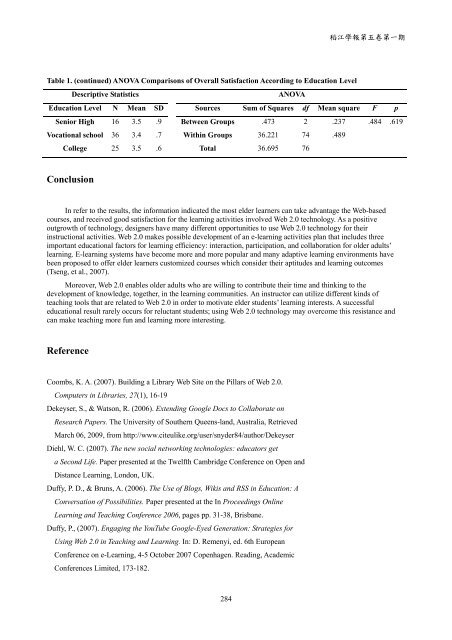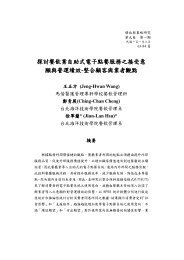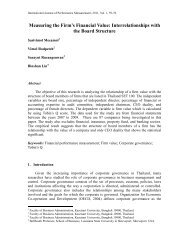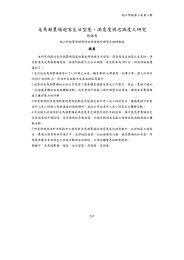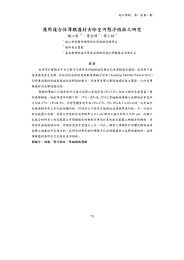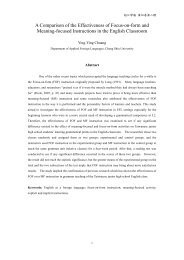ç®é - ç 究ç¼å±è - 稻æ±ç§ææ¨ç®¡çå¸é¢
ç®é - ç 究ç¼å±è - 稻æ±ç§ææ¨ç®¡çå¸é¢
ç®é - ç 究ç¼å±è - 稻æ±ç§ææ¨ç®¡çå¸é¢
You also want an ePaper? Increase the reach of your titles
YUMPU automatically turns print PDFs into web optimized ePapers that Google loves.
稻 江 學 報 第 五 卷 第 一 期<br />
Table 1. (continued) ANOVA Comparisons of Overall Satisfaction According to Education Level<br />
Descriptive Statistics<br />
ANOVA<br />
Education Level N Mean SD Sources Sum of Squares df Mean square F p<br />
Senior High 16 3.5 .9 Between Groups .473 2 .237 .484 .619<br />
Vocational school 36 3.4 .7 Within Groups 36.221 74 .489<br />
College 25 3.5 .6 Total 36.695 76<br />
Conclusion<br />
In refer to the results, the information indicated the most elder learners can take advantage the Web-based<br />
courses, and received good satisfaction for the learning activities involved Web 2.0 technology. As a positive<br />
outgrowth of technology, designers have many different opportunities to use Web 2.0 technology for their<br />
instructional activities. Web 2.0 makes possible development of an e-learning activities plan that includes three<br />
important educational factors for learning efficiency: interaction, participation, and collaboration for older adults’<br />
learning. E-learning systems have become more and more popular and many adaptive learning environments have<br />
been proposed to offer elder learners customized courses which consider their aptitudes and learning outcomes<br />
(Tseng, et al., 2007).<br />
Moreover, Web 2.0 enables older adults who are willing to contribute their time and thinking to the<br />
development of knowledge, together, in the learning communities. An instructor can utilize different kinds of<br />
teaching tools that are related to Web 2.0 in order to motivate elder students’ learning interests. A successful<br />
educational result rarely occurs for reluctant students; using Web 2.0 technology may overcome this resistance and<br />
can make teaching more fun and learning more interesting.<br />
Reference<br />
Coombs, K. A. (2007). Building a Library Web Site on the Pillars of Web 2.0.<br />
Computers in Libraries, 27(1), 16-19<br />
Dekeyser, S., & Watson, R. (2006). Extending Google Docs to Collaborate on<br />
Research Papers. The University of Southern Queens-land, Australia, Retrieved<br />
March 06, 2009, from http://www.citeulike.org/user/snyder84/author/Dekeyser<br />
Diehl, W. C. (2007). The new social networking technologies: educators get<br />
a Second Life. Paper presented at the Twelfth Cambridge Conference on Open and<br />
Distance Learning, London, UK.<br />
Duffy, P. D., & Bruns, A. (2006). The Use of Blogs, Wikis and RSS in Education: A<br />
Conversation of Possibilities. Paper presented at the In Proceedings Online<br />
Learning and Teaching Conference 2006, pages pp. 31-38, Brisbane.<br />
Duffy, P., (2007). Engaging the YouTube Google-Eyed Generation: Strategies for<br />
Using Web 2.0 in Teaching and Learning. In: D. Remenyi, ed. 6th European<br />
Conference on e-Learning, 4-5 October 2007 Copenhagen. Reading, Academic<br />
Conferences Limited, 173-182.<br />
284


